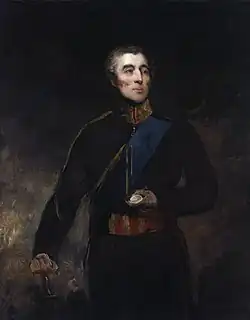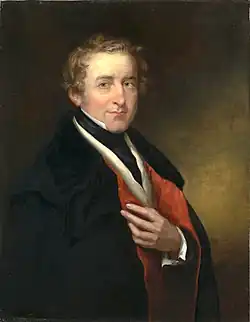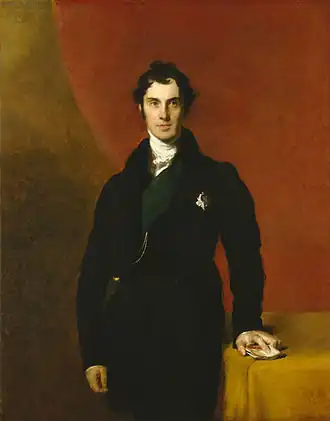The Conservative government of the United Kingdom of Great Britain and Ireland that began in 1828 and ended in 1830 was led by Arthur Wellesley, 1st Duke of Wellington in the House of Lords and Robert Peel in the House of Commons .
History
The Duke of Wellington finally came to power after the abortive attempt at a Canningite-Whig coalition government came to an end with Viscount Goderich 's resignation in January 1828. The government included several men from the previous administration, but four of the most important, Lords Dudley and Palmerston and Messrs Huskisson and Grant, resigned in May 1828.
Fate
The Duke oversaw the introduction of Catholic Emancipation , but remained resolutely opposed to parliamentary reform, and as a result lost a vote of no confidence on 15 November 1830. The Whigs under Lord Grey then formed the government which was to pass the Great Reform Act .
Cabinet
During his first seven months as prime minister, the Duke chose not to live in the official residence at 10 Downing Street , finding it too small. He moved in only because his own home, Apsley House , required extensive renovations
,
Portrait of the Duke of Wellington Thomas Phillips Portrait of Lord Aberdeen Thomas Lawrence , 1830. Lord Aberdeen served as Foreign Secretary .
Office
Name
Term
First Lord of the Treasury Leader of the House of Lords Arthur Wellesley, 1st Duke of Wellington January 1828 – November 1830
Lord Chancellor John Copley, 1st Baron Lyndhurst January 1828 – November 1830
Lord President of the Council Henry Bathurst, 3rd Earl Bathurst January 1828 – November 1830
Lord Privy Seal Edward Law, 2nd Baron Ellenborough January 1828 – June 1829
James St Clair-Erskine, 2nd Earl of Rosslyn June 1829 – November 1830
Chancellor of the Exchequer Henry Goulburn January 1828 – November 1830
Home Secretary Leader of the House of Commons Robert Peel January 1828 – November 1830
Foreign Secretary John Ward, 1st Earl of Dudley January 1828 – June 1828
George Hamilton-Gordon, 4th Earl of Aberdeen June 1828 – November 1830
Secretary of State for War and the Colonies William Huskisson January 1828 – May 1828
Sir George Murray May 1828 – November 1830
First Lord of the Admiralty Robert Dundas, 2nd Viscount Melville September 1828 – November 1830
Master-General of the Ordnance Henry Paget, 1st Marquess of Anglesey January 1828 – April 1828
William Carr Beresford, 1st Viscount Beresford April 1828 – November 1830
President of the Board of Trade Charles Grant January 1828 – June 1828
William Vesey-Fitzgerald June 1828 – February 1830
John Charles Herries February 1830 – November 1830
President of the Board of Control Charles Williams-Wynn January 1828 – July 1828
Robert Dundas, 2nd Viscount Melville July 1828 – September 1828
Edward Law, 2nd Baron Ellenborough September 1828 – November 1830
Master of the Mint John Charles Herries January 1828 – November 1830
Chancellor of the Duchy of Lancaster George Hamilton-Gordon, 4th Earl of Aberdeen January 1828 – June 1828
Charles Arbuthnot June 1828 – November 1830
First Commissioner of Woods and Forests Charles Arbuthnot February 1828 – June 1828
William Lowther, Viscount Lowther June 1828 – November 1830
Paymaster of the Forces William Vesey-Fitzgerald January 1828 – July 1828
John Calcraft July 1828 – November 1830
Secretary at War Henry Temple, 3rd Viscount Palmerston January 1828 – May 1828
Sir Henry Hardinge
May 1828 – July 1830
Lord Francis Leveson-Gower July 1830 – November 1830
Full list of ministers
Members of the Cabinet are indicated by bold face.
Notes
^ Office of Lord High Admiral put into commission from 19 September 1828.
^ Office of Lieutenant-General of the Ordnance vacant after 1830.
^ Office of Clerk of the Deliveries of the Ordnance abolished in 1830.
References
.svg.png)



.png)

.svg.png)